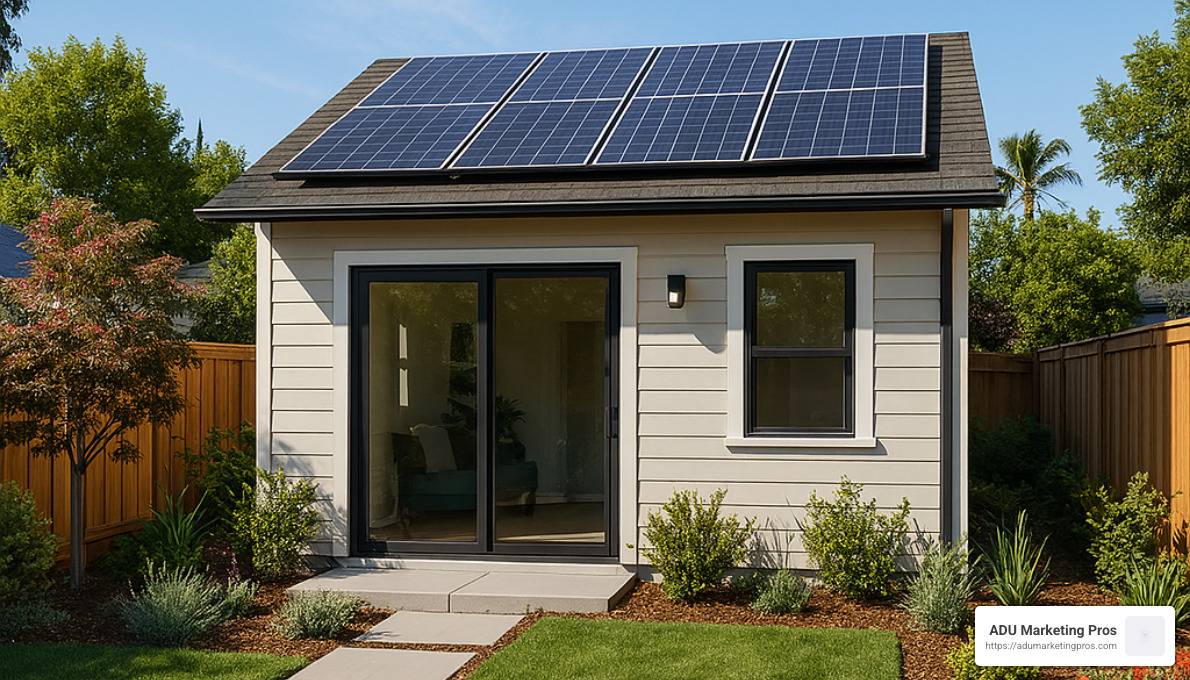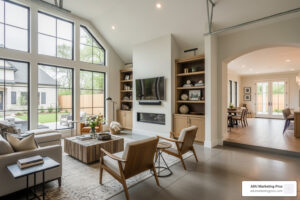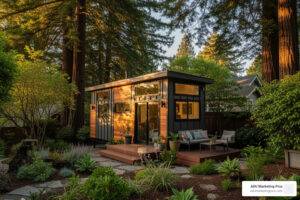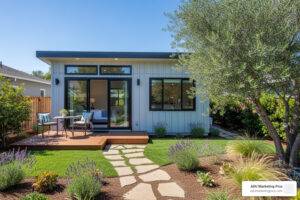Understanding ADUs
California ADU incentives are state and local programs designed to encourage homeowners to build Accessory Dwelling Units (ADUs). These incentives help offset costs and simplify the process of adding units like granny flats, backyard cottages, or converted garages to your property—supporting affordable housing and easing the state’s housing shortage.
Quick overview of California ADU incentives:
- CalHFA ADU Grant: Up to $40,000 toward planning and initial building costs.
- Local Permit Fee Reductions: Many cities offer fee waivers or discounts.
- Tax Benefits: Possible energy-efficient credits and tax deductions.
- Flexible Financing Options: Special loans and refinancing plans available for ADU construction.
California is in the midst of a housing crunch—especially in urban areas. Rising housing prices and limited land have made it tougher to find affordable homes. ADUs can be an effective solution, providing extra income for homeowners and affordable rentals for tenants. Thankfully, California ADU incentives make building these units easier, faster, and more affordable.

Similar topics to California ADU incentives:
Accessory Dwelling Units, commonly known as ADUs, have been called many things over the years: granny flats, in-law units, backyard cottages, secondary units, or casitas. But no matter what you call them, these versatile living spaces are revolutionizing California’s approach to housing.
ADUs are self-contained residential units that can be added to an existing property. They typically include:
- A full kitchen
- Bathroom facilities
- Sleeping area
- Separate entrance from the main dwelling

There are several types of ADUs that California homeowners can consider:
- Detached ADUs: Standalone structures built in the backyard of the main house
- Attached ADUs: Connected to the primary residence, often with a separate entrance
- Garage Conversions: Changing an existing garage into living space
- Junior ADUs (JADUs): Smaller units (up to 500 sq ft) created within the walls of the main house
“ADUs are a win-win solution for California’s housing crisis,” says Maria Rodriguez, a San Jose homeowner who recently built an ADU for her aging mother. “My mom gets to maintain her independence while being close enough for us to help when needed, and eventually, it could become rental income for our family.”
At ADU Marketing Pros, we’ve seen how these versatile spaces are changing neighborhoods across the San Francisco Bay Area, Los Angeles, San Diego, and beyond. They’re not just additional living spaces—they’re multigenerational housing solutions, income opportunities, and a creative response to California’s housing shortage.
California ADU Incentives
California has acceptd ADUs as a key solution to its housing crisis, rolling out some seriously impressive incentives to help homeowners take the plunge. These programs aren’t just token gestures—they’re game-changers designed to make ADU construction financially feasible for everyday Californians.
CalHFA ADU Grant Program
If you’ve been hesitating about building an ADU because of startup costs, the California Housing Finance Agency (CalHFA) ADU Grant Program might be exactly what you need. This remarkable program offers homeowners up to $40,000 to cover those initial expenses that often prevent projects from getting off the ground.
Think about those early-stage costs that add up quickly: architectural designs that bring your vision to life, permits that can cost thousands, site preparation work, necessary soil tests, detailed property surveys, and energy reports required by local authorities. The CalHFA grant covers all of these pre-development expenses.

What makes this opportunity truly special is that it’s a grant, not a loan. As long as you follow the program guidelines, that money is yours to keep—no repayment required!
To qualify for this generous California ADU incentive, you’ll need to check a few boxes: you must own and live in a single-family home in California, meet the income requirements (typically capped at 80% of your area’s median income), ensure your ADU plans comply with local regulations, and work with CalHFA-approved professionals for your project.
Local Government Incentives
The support for ADUs doesn’t stop at the state level. Cities and counties across California have created their own incentive programs to encourage backyard homes and garage conversions.
In San Jose, homeowners can choose from pre-approved ADU plans that significantly speed up the permitting process—saving both time and architectural fees. Down in Los Angeles, substantial fee reductions await those planning to use their ADUs as affordable housing units. San Francisco offers hands-on technical assistance through their dedicated ADU program, while San Diego has both streamlined their permitting and reduced impact fees.

We’ve seen these local incentives make real differences for homeowners. Thomas Chen, who worked with one of our ADU Marketing Pros clients in Palo Alto, told us: “The local incentives in Palo Alto made our decision to build an ADU much easier. The pre-approved plans saved us thousands in architectural fees and cut our timeline by months.”
Recent Legislative Support
In the years leading up to 2025, the California legislature has been remarkably consistent in its support for ADUs, passing a series of laws that have transformed these once-niche housing options into mainstream solutions.
The year 2020 was particularly significant, with AB 68, AB 881, and SB 13 streamlining approval processes and removing many traditional barriers to ADU construction. That same year, AB 670 prevented homeowners associations from putting unreasonable restrictions on ADU projects, while AB 671 took things a step further by requiring local governments to include ADU incentives in their housing plans.
More recently, AB 345 (2022) opened new possibilities by enabling separate sale of ADUs under certain circumstances—a potential game-changer for property owners looking at ADUs as long-term investments. As of 2025, these legislative changes remain in effect, continuing to shape the ADU landscape for homeowners across the state.

This consistent legislative support has created a far more welcoming environment for ADU development than existed just a few years ago. What was once a complicated, expensive process has become increasingly accessible to average homeowners across the state.
For more detailed information on ADU legislation, you can visit the California Department of Housing and Community Development.
At ADU Marketing Pros, we’ve watched these California ADU incentives transform possibilities for both homeowners and the construction firms we work with. The combination of state grants, local programs, and supportive legislation has created a unique moment of opportunity for addressing California’s housing needs through these versatile, practical living spaces.
Financing Your ADU
You’ve explored the fantastic California ADU incentives, like the helpful CalHFA ADU grant, which covers pre-development costs. But what about financing the actual construction? Thankfully, there are several practical options to help you fund your dream ADU smoothly and affordably.
Home Equity Loans and HELOCs
One of the most popular ways homeowners finance their ADU project is by tapping into their home’s equity. If you’ve owned your home for a while, chances are you’ve built substantial equity. You can access this equity through home equity loans and home equity lines of credit (HELOCs).
A home equity loan works like a traditional loan, giving you a lump sum upfront, usually with a fixed interest rate. This lets you budget and plan effectively since your monthly payments stay the same.
On the other hand, a HELOC functions like a credit card, offering flexibility to borrow funds when you need them. It has a variable interest rate, meaning payments may fluctuate over time. Both options are appealing because they’re secured by your property, leading to lower interest rates compared to personal loans.
Construction Loans
If you’d prefer a solution custom specifically to building projects, a construction loan might be your perfect match. Unlike typical loans, a construction loan offers short-term financing that becomes permanent financing once the build is complete. Funds are often released in stages, matching the different phases of your construction project.
Many lenders offer a “construction-to-permanent” option, meaning you seamlessly transition into a long-term mortgage without the hassle and cost of separate closings. Elena Gomez from Sunnyvale shares her experience: “Financing was my biggest concern when planning our ADU. Working with a lender who understood the unique aspects of an ADU project made all the difference. They guided us through both the CalHFA grant and a custom construction loan that fit our budget.”
Cash-Out Refinance
Another practical choice worth exploring is a cash-out refinance. With this option, you refinance your current mortgage into a new, larger loan, and then you “cash out” the difference to fund your ADU.
The main attraction here is that refinancing often offers lower interest rates than other financing solutions—saving you money in the long run. Just keep in mind, this solution resets your mortgage timeline and may involve additional closing costs.
ADU-Specific Financing Programs
As ADUs gain popularity, lenders are beginning to offer special financing programs explicitly designed for ADU projects:
- The CalHFA ADU Program partners with traditional lenders to provide combined financing packages custom for ADU projects.
- Many local credit unions in California now offer specialized ADU loan products with competitive rates and flexible terms.
- Community organizations known as Community Development Financial Institutions (CDFIs) also provide attractive financing options, especially aimed at moderate-income homeowners.
At ADU Marketing Pros, we’ve seen how choosing the right financing can make or break your ADU project. Our homeowners in cities like Mountain View, Menlo Park, and across the San Francisco Bay Area have successfully combined these financing tools, creating affordable solutions to realize their dream ADUs.
No matter what financing option you choose, the key is finding experienced lenders and contractors who understand ADU-specific projects. With a thoughtful approach and informed guidance, your ADU investment can smoothly transition from a vision into affordable, comfortable housing that boosts your property value and supports your financial future.
Cost of Building an ADU in California
If you’re considering an ADU, a big part of the planning process is understanding the costs involved. California ADU incentives can significantly offset expenses, but knowing the average costs upfront helps you budget realistically and ensure your project is financially viable.
Let’s break down what you might expect to spend on different types of ADUs, what factors contribute to these costs, and some smart strategies to keep your project within budget.
Average Costs by ADU Type
The cost of building an ADU in California largely depends on what kind you choose. For example, converting your garage into an ADU tends to be the most wallet-friendly option, typically ranging from $80,000 to $150,000 for around 250-400 sq ft. Junior ADUs (JADUs), which are smaller units built within your main home’s existing walls, usually cost about $50,000 to $100,000 for up to 500 sq ft.
Going a little bigger, an attached ADU—built as an addition to your existing house—costs around $150,000 to $300,000 for a 500-800 sq ft space. For a larger, detached backyard cottage (600-1,200 sq ft), you’re looking at an average cost of $200,000 to $400,000.
These numbers are averages—your costs might be lower or higher based on your choices and location.
Cost Breakdown
Understanding exactly where your money goes can help you budget wisely and make educated choices. A typical ADU project can be roughly divided into four main cost areas:
-
Pre-development Costs: Around 10-15% of your total budget typically goes here. This includes architectural design, engineering reports, permits, fees, and site surveys. Luckily, this is the kind of expense the CalHFA ADU grant (up to $40,000) is specifically meant to cover.
-
Site Preparation: Expect another 5-15% of your total cost to go toward getting your property ready. This includes foundation work, utility hookups, excavation, and demolition if you’re converting an existing structure like a garage.
-
Construction Costs: This is the biggie—around 60-70% of your budget. It covers the actual building materials, labor, appliances, fixtures, finishes, and everything that turns your ADU from plans on paper into a livable space.
-
Contingency Fund: Construction surprises are common, so it’s smart to set aside around 10-15% of your total budget as a safety cushion for unexpected costs or changes.

Regional Cost Variations
California is a big state, and costs definitely vary depending on your region. In general, urban and coastal areas like the San Francisco Bay Area have the highest building costs—detached ADUs here can often exceed $400,000. Other major cities, like Los Angeles, usually see slightly lower prices in the $250,000-$350,000 range for a detached unit. Costs in San Diego tend to land between $200,000 and $300,000.
If you’re in inland or rural areas (think Central Valley or parts of Southern California away from major cities), you’ll usually find more affordable options. Some ADU projects here can even be completed under $200,000.
Michael Patel, a homeowner in Mountain View who worked with an ADU Marketing Pros partner firm, shares a helpful perspective: “We were initially shocked by the high cost estimates. But when we factored in the CalHFA grant and our expected rental income of $2,800 per month, it started looking like a smart financial move. We realized we’d recoup our investment in about 8 years.”
Cost-Saving Strategies
Even with generous California ADU incentives, it’s always good to keep expenses manageable. Here are some practical tips that can save you money without sacrificing quality:
-
Consider prefab or modular ADUs: These factory-made units can lower your overall costs by 10-20% and significantly speed up the building process.
-
Keep your design simple: A rectangular layout and standard dimensions can save you thousands of dollars compared to complicated custom designs.
-
Go for a garage conversion if possible: If you already have a garage you don’t use much, converting it is typically the cheapest route. You’ll avoid big expenses like foundation work and exterior walls.
-
Build in phases: If budget is tight, consider building the structure first and finishing the interior over time. Just be sure to plan carefully to avoid extra costs later.
-
Invest in energy-efficient features: While energy-efficient fixtures, insulation, and solar panels might cost more upfront, you’ll save on utilities over time and may qualify for additional rebates and tax credits.
At ADU Marketing Pros, we’ve seen how a smart approach to budgeting combined with available incentives can turn ADUs into a win-win project. Whether your goal is creating affordable housing for family members or generating rental income, careful planning makes all the difference.
Frequently Asked Questions about California ADU Incentives
What are the incentives to build an ADU in California?
California offers some fantastic incentives to encourage homeowners to build ADUs, making it easier and more affordable than ever before. One of the most popular is the CalHFA ADU Grant Program, which gives eligible homeowners up to $40,000 toward pre-development costs. These are expenses you’ll face before building starts, like permits, architectural designs, engineering plans, and site preparation.
Beyond the state-level grants, California has rolled out policies to make the process smoother and more affordable. For example, the permitting process for ADUs has been significantly streamlined. Local governments are now required by law to process your ADU permits within just 60 days through a straightforward, ministerial review process. Sarah Johnson, who built an ADU in Palo Alto, shared, “The streamlined permitting process saved us at least three months. Our neighbors went through permitting before these laws passed, and it took them over a year!”
Additionally, many cities and counties have reduced or even eliminated impact fees for smaller ADUs under 750 square feet. You might also benefit from relaxed zoning rules, which mean there’s generally no minimum lot size to worry about and reduced setback distances from property lines. Plus, many local utilities now offer fee waivers or substantial discounts when you’re connecting your ADU to water, power, or sewer.
Can you write off ADU in California?
While you can’t directly write off the entire cost of an ADU in California, several valuable tax benefits can significantly lower your overall expense. For starters, certain California counties offer property tax incentives such as temporary exemptions or reduced assessments if your ADU will be dedicated to affordable housing.
Additionally, choosing energy-efficient options can lead to savings. Federal tax credits are available when you install energy-saving features like solar panels, high-quality insulation, or ENERGY STAR-approved appliances. Robert Wilson from Menlo Park says, “We installed solar panels on our new ADU and got a 30% federal tax credit. Coupled with our lower energy bills, this has noticeably improved our project’s overall financial picture.”
If you rent out your ADU, you can also claim rental property deductions. Typical expenses like mortgage interest, property taxes, insurance, and ongoing maintenance are deductible. Even the depreciation of your ADU can help lower your taxable income. To make sure you’re maximizing these benefits, it’s always wise to talk to a tax professional who understands your specific situation.
How to get money to build an ADU in California?
Even with the various California ADU incentives available, you’ll likely need additional financing to cover the construction costs of your ADU. Luckily, there are several practical ways to fund your project.
A popular choice among homeowners is tapping into home equity through a home equity loan or HELOC (home equity line of credit). These options usually come with lower interest rates, since your home serves as collateral.
Another effective solution is a construction loan, specifically designed for building projects. Construction loans generally release funds in stages as the project moves forward, converting to a traditional loan once building is complete. A cash-out refinance is another strategy, letting you replace your current mortgage with a larger loan so you can use the extra cash for construction.
Additionally, specialized renovation loan programs like FHA 203(k) or Fannie Mae HomeStyle can help finance both the purchase and renovation of properties, including adding an ADU.
Certain local governments have unique financing programs dedicated to ADU projects: San Francisco offers the ADU Financing Program, Los Angeles provides the ADU Accelerator Program, and San Jose supports homeowners with its ADU Ally Program.
Some homeowners even partner with private investors who provide upfront capital in exchange for part of your ADU’s rental income down the road.
David Chen from Sunnyvale combined the CalHFA grant and a HELOC to fund his backyard cottage. “The $40,000 grant covered all our architectural plans, permits, and site prep,” he explains, “while the HELOC financed the actual construction. Now, my monthly rental income more than covers the HELOC payments.”
At ADU Marketing Pros, we’ve seen many clients from across the San Francisco Bay Area successfully combine multiple funding sources to make their ADU dreams a reality. Our partner construction firms have extensive experience guiding homeowners through these financial decisions, helping to ensure a smooth and affordable building experience.
Conclusion
Thanks to the wide variety of California ADU incentives, building an accessory dwelling unit has shifted from a complicated, costly project into a realistic and rewarding opportunity for homeowners across the Golden State. Programs like the generous CalHFA ADU Grant, streamlined permits, and specialized financing have cleared the path, enabling more Californians than ever to accept ADUs as part of their future.
Why is this important? Well, California is still facing a serious housing crunch. Home prices continue to climb, and affordable options remain scarce. ADUs beautifully solve this puzzle by providing homeowners with extra rental income, increased property value, and flexible living options for family members. At the same time, they help communities gently increase neighborhood density without dramatically changing their character. For the state, ADUs mean more affordable housing units without needing massive public investments.

At ADU Marketing Pros, we’re all about connecting homeowners with the very best ADU construction and architecture firms in Los Angeles, San Diego, the San Francisco Bay Area, and throughout California. Our partners know these California ADU incentives inside out, ensuring homeowners maximize every available benefit.
Jennifer Lee, an ADU specialist working with one of our partner firms in San Jose, recently summed it up nicely: “The landscape for ADUs in California has never been more favorable. Homeowners at all income levels are finally able to build ADUs that meet their unique needs—and help ease the housing crisis at the same time.”
Whether you’re considering an ADU as a cozy home for aging parents, a smart rental investment, or a welcoming space for grown-up kids to visit (and maybe stay!), now is the ideal moment. The combination of supportive California ADU incentives and guidance from experienced professionals can transform your backyard into something truly special.
Ready to explore a backyard cottage, granny flat, or garage conversion? Visit us at ADU Marketing Pros—let us connect you with specialized ADU construction and architecture firms who can guide you through using these incentives to make your dream ADU a reality.




